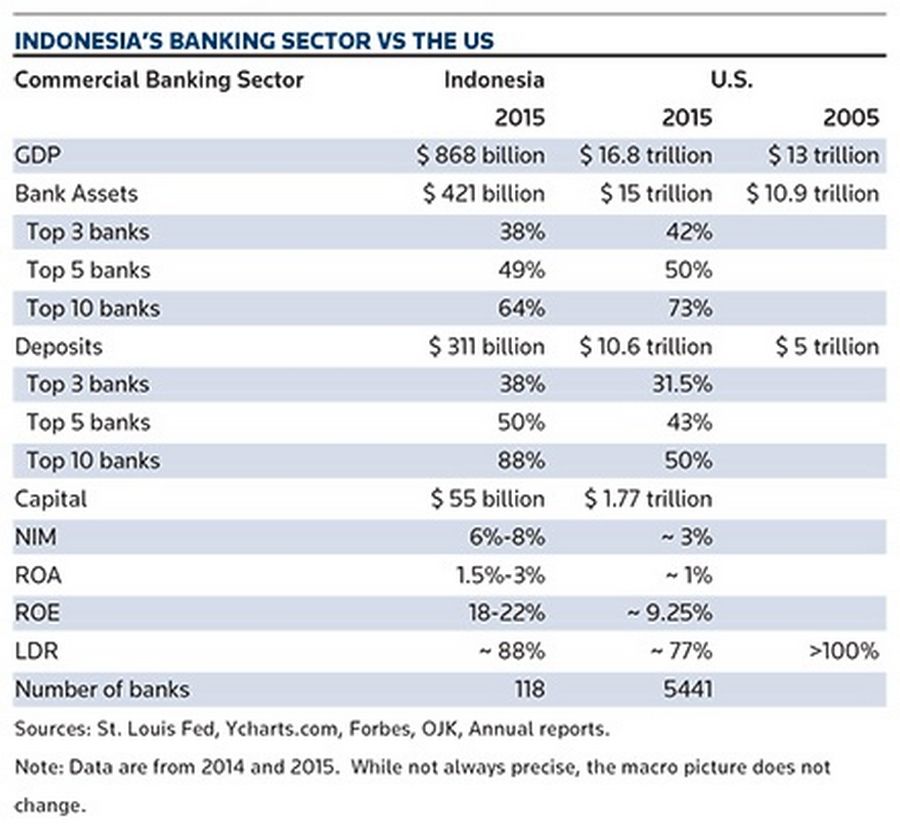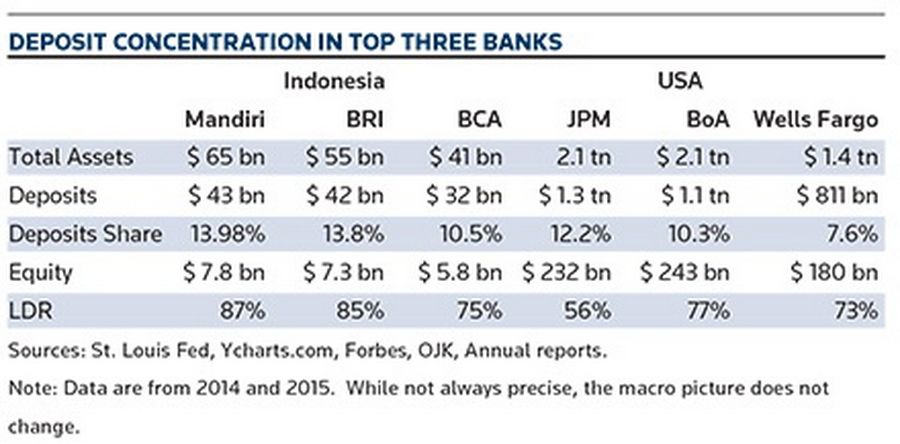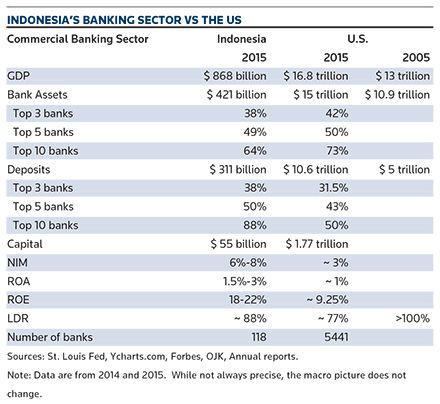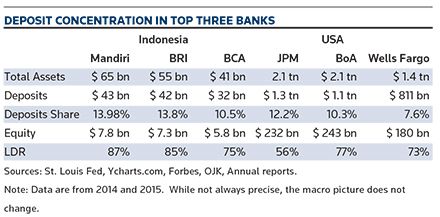Would you lend your money at a low interest rate to a company whose balance sheet is 10 times levered? The answer may be obvious, yet trillions of dollars have found their way into bank deposits that do just that, thanks to explicit and implicit government guarantees that your money will be protected.
To be allowed to collect people’s savings as low-cost deposits with government backing is a privilege. Those entrusted with this privilege must have two primary tasks: to safeguard those deposits, and to finance investments in the very country whose savings they are borrowing. Since governments have a hand in supporting depositors, the banks themselves need to focus on making substantial contributions to the economy. Deposits are the foundation on which credit in the broader economy is multiplied – especially in developing countries such as Indonesia, where capital markets and alternative routes of credit creation are severely constrained.
Corporate borrowers who are investing and expanding with clear equity contributions and transparent invoicing must be able to borrow at attractive rates in the local bank market.
A comparison with the US shows there is considerable room for Indonesia’s banks to put their deposits to more productive use. To encourage this, regulators should pay particular attention to the concentration of deposits among the top 10 banks in Indonesia – especially among the top three – as well as the type of credit banks provide. Banking sector leverage can also be enhanced further with non-deposit sources, translating into a larger balance sheet and more credit for the economy.
In Indonesia, banking sector assets are equivalent to 48.5% of GDP, versus 89% in the US. The ratio of banking assets to deposits also trails the US, with a multiplier of 1.35 in Indonesia against 1.41 in the US.
This is really unfortunate for Indonesia’s developing economy. If anything, both ratios should be the other way around. In a developing country like Indonesia where banking remains the primary source of credit, there is definitely room for the deposits to be more productive and form the base for higher leverage.

Indonesia’s three biggest banks control 38.3% of all deposits, well above the 30% share for their US counterparts, but are lending less. The assets-to-deposits ratio for Bank Mandiri, Bank Rakyat Indonesia and Bank Central Asia is 1.51, 1.30 and 1.28, respectively, while it is 1.92, 1.90 and 1.72 for JP Morgan, Bank of America Merrill Lynch and Wells Fargo. The under-provision of credit by Indonesia’s top banks is apparent in these figures.
Indonesia’s modest LDR ratios may look like a positive versus the US system, but one has to remember that the US economy is facing challenges from a lack of demand. This is just not the case in Indonesia, where there is significant pent-up demand for credit in both the corporate and consumer sectors.
Since the cheapest form of leverage is so much less productive, Indonesia’s economy as a consequence suffers from much higher financing costs. This higher cost is borne by both the corporate sector (to the extent credit is available to it) and by the consumers – most of whom are highly vulnerable.
Loan portfolios are also directed toward lower-risk asset classes, leading to very attractive risk-adjusted returns. Banks may point to the 1998 experience to justify their conservative policies, but times have changed and a vigilant central bank can prevent many of the risks of pre-1998 era. Corporate borrowers who are investing and expanding with clear equity contributions and transparent invoicing must be able to borrow at attractive rates in the local bank market.

Recommendations
Regulators can and should play an active role in encouraging top banks to support the economy.
(a) The most obvious first step is for regulators to look beyond LDRs when setting limits for bank lending. The type of loan, working capital or capital investment, makes a big difference for long-term economic prospects. A skew toward working capital suggests a “trading economy”, while more term loans would suggest a skew toward manufacturing.
(b) Corporate loans must be benchmarked against regional and international indices. Credit spreads in US dollars and euros are widely available and can be used as a benchmark for regulators to assess competitiveness or collusion in the local currency bank loan market.
(c) Alternate sources of leverage, such as the repo market or international money markets, must be aggressively developed and used to expand bank balance sheets.
(d) Greater competition for savings must be encouraged. If banks have to compete against capital market alternatives or peer-to-peer lending platforms, they will have to pay more for deposits and lend more competitively to generate better returns.
(e) A cap on any single bank’s share of total deposits must be considered. Deposits above the threshold of, say, 8%–10% should be ceded for a nominal fee to a new, independent bank that will be better positioned to leverage those deposits and build the country’s productive capacity. This is probably the most contentious of the policy recommendations, but such a cap will not be unique: the US has maintained a cap of 10% of total deposits for any single bank since 1994.
(f) An appeals panel should be set up to further address bank lending. Any corporation that has a loan rejected, a decision frozen or faces unviable interest costs can appeal, while banks will face fines or more stringent penalties if they refuse to fund viable investment proposals. This will ensure matters like ethnicity, unrelated personal conflicts and so on do not influence lending decisions and eventually hinder economic growth. Frivolous appeals should also be penalised.
To conclude, Indonesia requires significant investments in infrastructure, manufacturing and services to transition its economy and cut its reliance on commodities. Regulators must actively encourage the country’s banks to enable this economic restructuring.
*Anand Haridh heads investments and restructuring for Bakrie & Brothers, a business group based in Indonesia and is a former investment banker. Mamat Rohimat, an analyst at the same firm, assisted in data collection.
| Commercial Banking Sector | Indonesia | US | |
|---|---|---|---|
2015 | 2015 | 2005 | |
GDP | US$868bn | US$16.8trn | US$13trn |
Bank Assets | US$421bn | US$15trn | US$10.9trn |
Top 3 banks | 38% | 42% | |
Top 5 banks | 49% | 50% | |
Top 10 banks | 64% | 73% | |
Deposits | US$311bn | US$10.6trn | US$5trn |
Top 3 banks | 38% | 31.5% | |
Top 5 banks | 50% | 43% | |
Top 10 banks | 88% | 50% | |
Capital | US$55bn | US$1.77trn | |
NIM | 6%-8% | ~ 3% | |
ROA | 1.5%-3% | ~ 1% | |
ROE | 18-22% | ~ 9.25% | |
LDR | ~ 88% | ~ 77% | >100% |
Number of banks | 118 | 5,441 | |
Sources: St. Louis Fed, Ycharts.com, Forbes, OJK, Annual reports. Note: Data are from 2014 and 2015. While not always precise, the macro picture does not change. | |||
| Indonesia | USA | |||||
|---|---|---|---|---|---|---|
Mandiri | BRI | BCA | JPM | BoA | Wells Fargo | |
Total Assets | $ 65 bn | $ 55 bn | $ 41 bn | 2.1 tn | $ 2.1 tn | $ 1.4 tn |
Deposits | $ 43 bn | $ 42 bn | $ 32 bn | $ 1.3 tn | $ 1.1 tn | $ 811 bn |
Deposits Share | 13.98% | 13.8% | 10.5% | 12.2% | 10.3% | 7.6% |
Equity | $ 7.8 bn | $ 7.3 bn | $ 5.8 bn | $ 232 bn | $ 243 bn | $ 180 bn |
LDR | 87% | 85% | 75% | 56% | 77% | 73% |
Sources: St. Louis Fed, Ycharts.com, Forbes, OJK, Annual reports. Note: Data are from 2014 and 2015. While not always precise, the macro picture does not change. | ||||||


